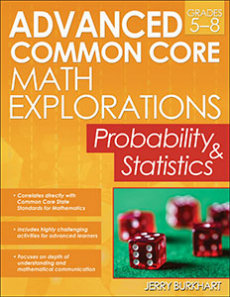Challenge Kids to Explore Probability and Statistics
Advanced Common Core Math Exploration: Probability and Statistics, Grades 5-8
By Jerry Burkhart
(Prufrock, 2017 – Learn more)

It’s okay to let students grapple with challenging math problems. In fact, it is the main idea of Advanced Common Core Math Explorations: Probability & Statistics Grades 5-8 by Jerry Burkhart. This book contains nine mathematical explorations ranging from number relationships in data to discrete probabilities.
The explorations are correlated to the Common Core State Standards for Mathematical Content. Problems are provided that are complex and open ended, “crossing grade levels and content strands.” Within the goals, the author clearly states that they are designed to “deepen students’ understanding of middle school math concepts” and to “improve mathematical communication skills.”
Encouraging students to be in charge of their learning

However, as problems become more complex, it becomes necessary for a student to put their ideas and calculations on paper. It is also important to communicate with others as they attempt to solve problems. For all but the most unusual students, peer to peer communication is key to expanding conceptual understanding, as well as to considering how to use different mathematical strategies.
Eight motivation strategies along with an assessment tool
“Eight Motivation Strategies” are provided in the Teacher’s Guide. They include “letting the students know what to expect, redefine success, praise effort over ability, focus on process more than answers, offer emotional support, meaningful responses to written work, allow student to collaborate, and debrief.” (page 8)
Burkhart provides an assessment tool (page 15) that is “targeted specifically to objectives that will keep you and your students focused on the deep concept-oriented learning that is at the heart of the Common Core State Standards for Mathematical Practice.” (page 4)
Exploring beyond comfort zones
The explorations are not easy, but they offer a great opportunity for students to step outside of their math comfort zone and grow as mathematical thinkers. As Burkhart states, “They will learn more from thinking deeply about one or two problems than from rushing to finish a lot of them.” (page 5) Students will also find themselves showing their ideas in different ways, ranging from traditional numbers and symbols to drawings and diagrams.
Each exploration gives a summary of what the activity involves, the concepts students will need to use, what tools may be necessary (ex: calculator) and what students will learn. Each exploration is broken into three stages, gradually becoming more complex. Conversation starters and solutions are also provided.
Direct instruction is not part of these explorations. Finding time for class discussions and group discussions sharing out thinking and processes is where the learning is captured. Teachers are to be asking rather than answering questions, “moving the discussion forward.”
Burkhart also provides examples of how to use the explorations (flexible groups, class conversations, etc.) along with how to assess student learning. An appendix gives additional procedures and examples to help extend the learning. Models and examples are given along with definitions of mathematical terms that may not have been introduced yet.
Differentiation to benefit most middle schoolers
As an intermediate teacher, I would use these explorations as challenges for my accelerated math students. Given the varied stages provided, I would also extend certain explorations to any of my students who are interested and would work collaboratively to problem solve. The explorations would provide upper middle school students with creative, and differentiated, problems to solve, as well as provide a review of learned concepts.
Kathleen Palmieri is a fifth grade teacher in upstate New York. With a passion for literacy and learning in the classroom, she participates in various writing workshops and curriculum writing endeavors. As a lifelong learner, she is an avid reader and researcher of educational practices and techniques. Collaborating with colleagues and globally on Twitter @Kathie042500 is an ongoing practice.






























